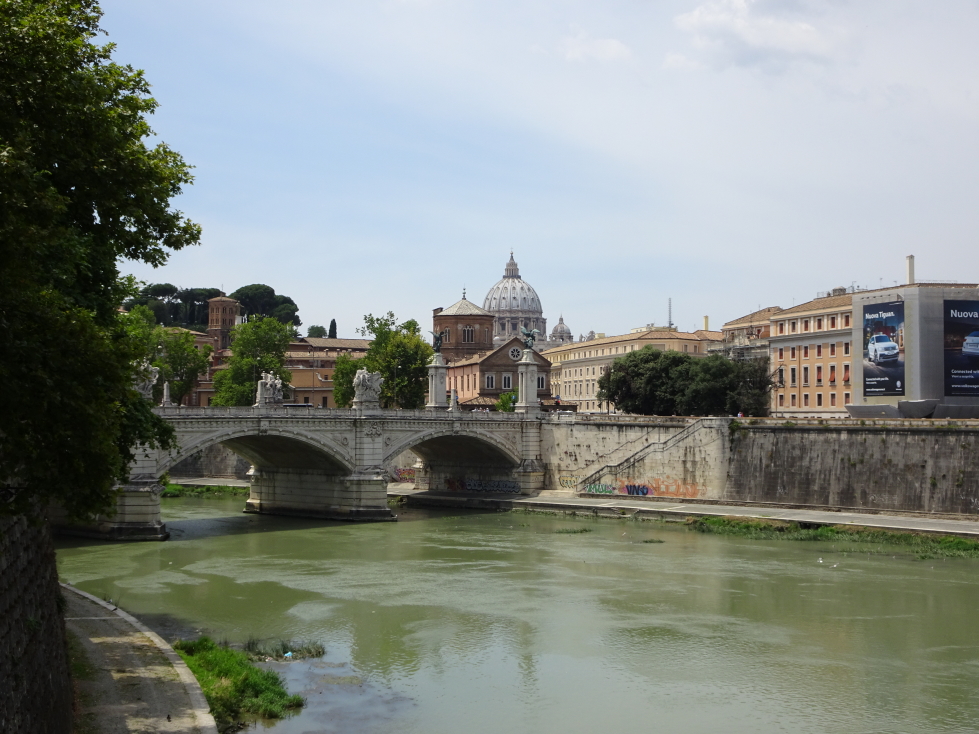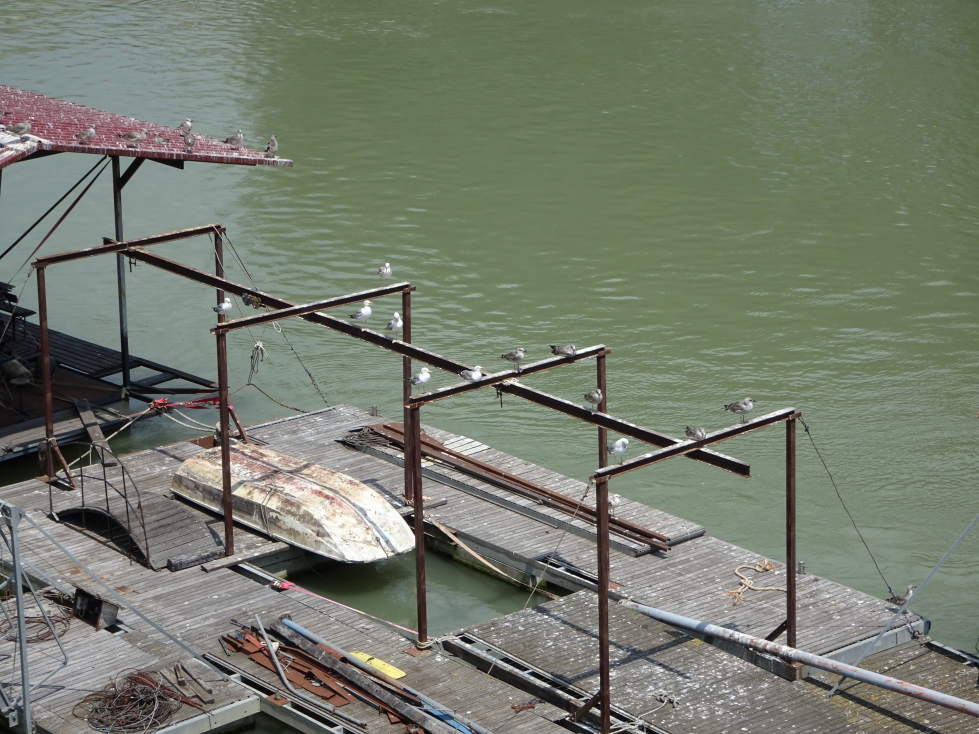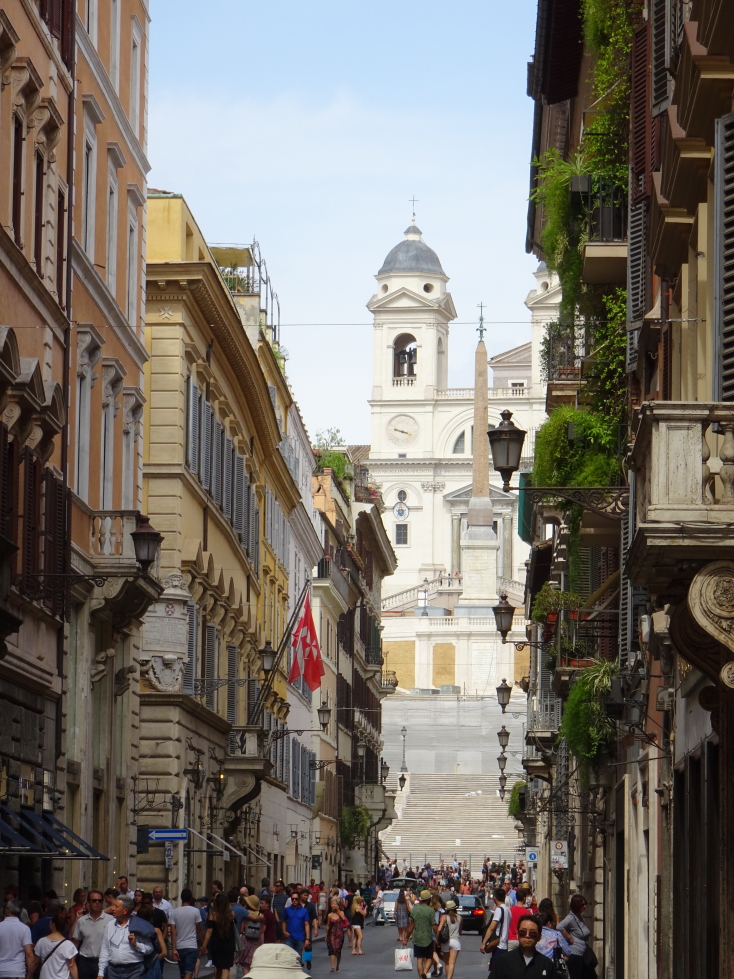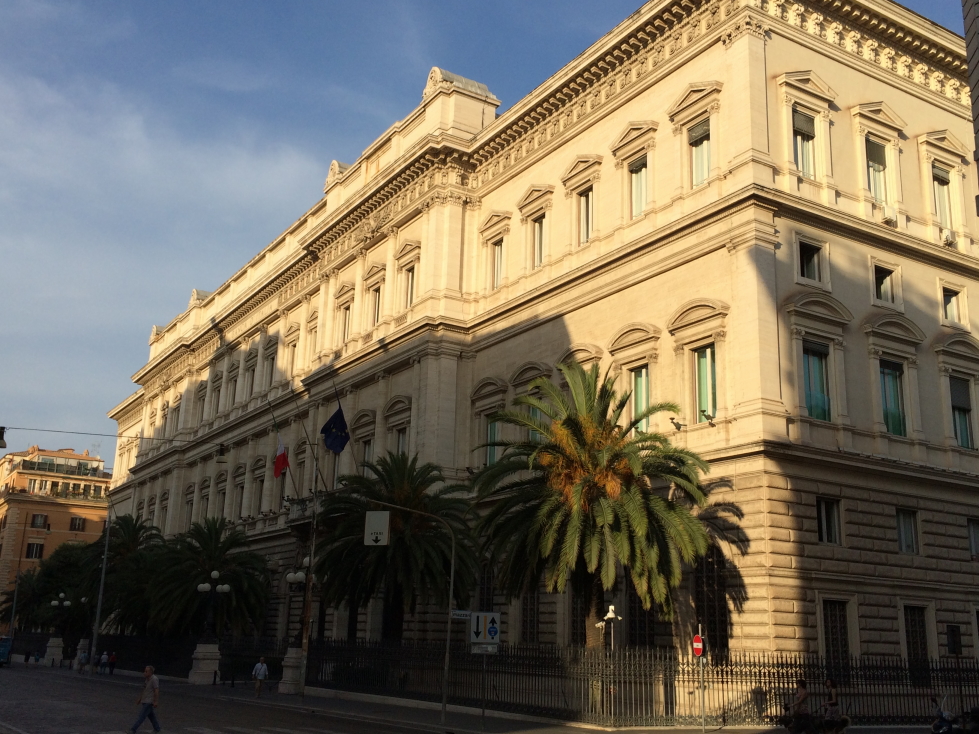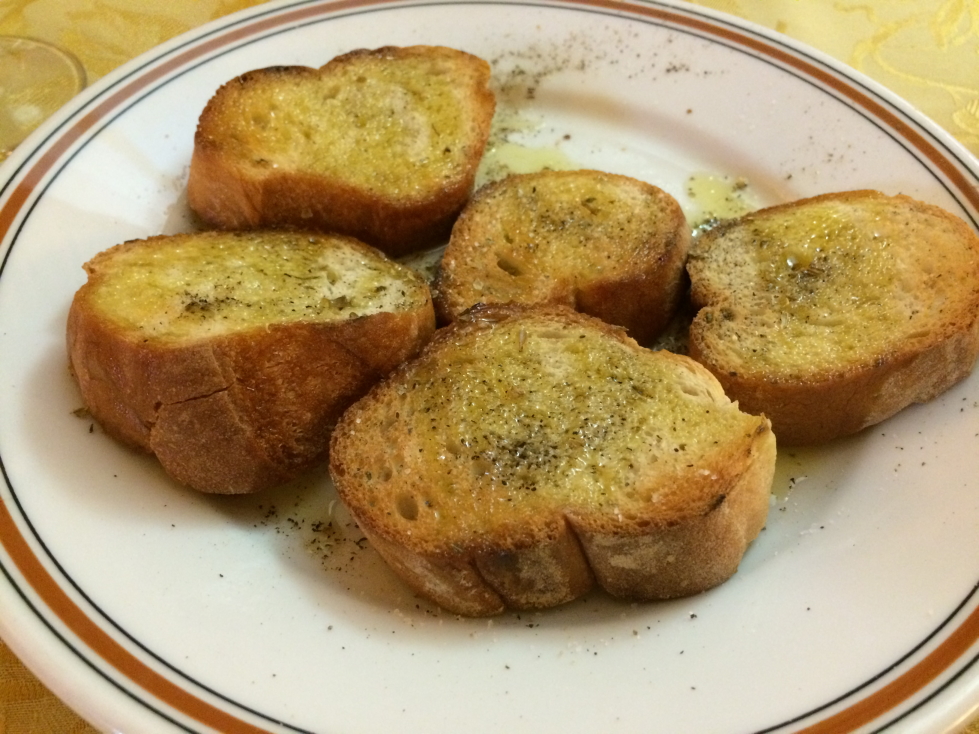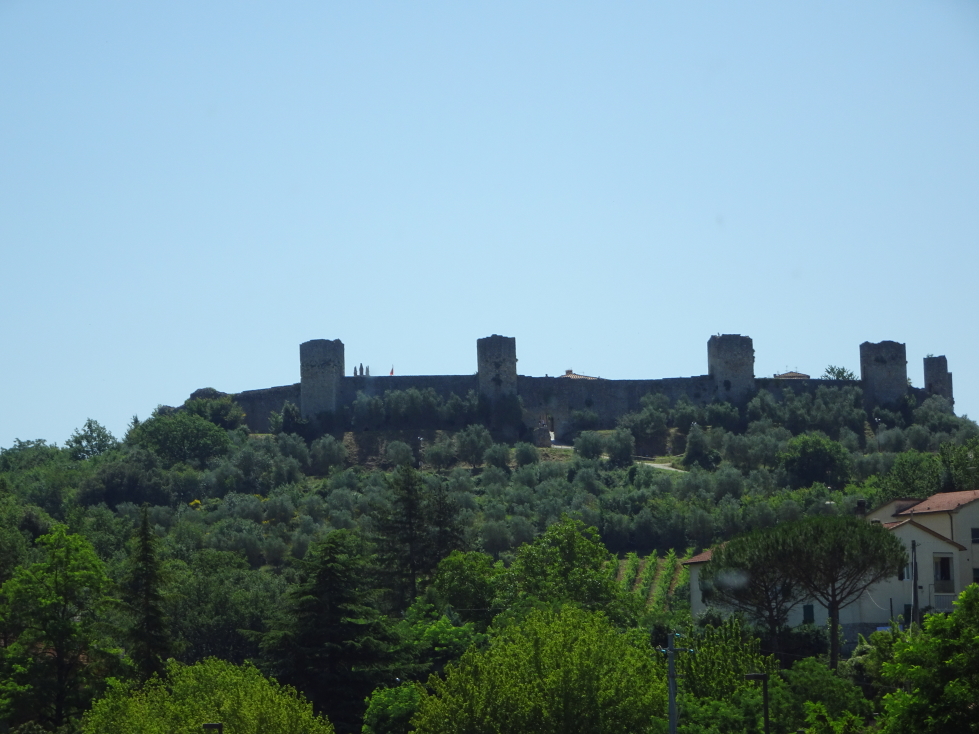As Michelle and Addison were leaving this morning we awoke at 3:15a. The next hour and change were a blur, getting them up and out for the 4:30a taxi pickup that would take them to the airport. Returning to my room I read up on Ostia Antica and talked a bit with the hotel’s night desk man about how to go about getting there. Went back to sleep about 6a, awakening at 8a. After a quick shower and breakfast I set out on my solo adventure just before 10a.
My first stop was a barber as my beard had grown quite a bit during the two weeks in Italy and was itching like crazy, especially as I was back in the heat of Rome. He didn’t speak a lick of English but I managed to get a shave (a rough one, a bit of blood here and there). Still, a shave is a shave and it felt great to be rid of the beard.
Walked past the Colosseum from a new vantage point as well as the Arch of Constantine and Palatine Hill. A bit further lay the massive Circus Maximus, its far end set up for the second night of a Pink Floyd (at least Gilmour) concert.

Nice view of the entirety of the Colosseum

Another view of the Colosseum

The Arch of Constantine

Circus Maximus with the concert stage at the far end
After a short walk along tree lined avenues and houses covered in all manner of flowering bushes I saw the Piramide di Caio Cestio, or Pyramid of Cestius, a tomb built in 12BC in the style of the pyramids in Egypt (which were quite ancient by then — in fact the Pyramid of Cestius is still closer to the present day than the pyramid it copied by almost 600 years!). It stood 125 feet high and 100 feet a side at the base and was quite impressive with its shining white marble facade! Across the street was the Porta San Paolo, one of the main gates into Rome built in the third century.

House covered by a gorgeous purple flowering vine

Pyramid of Cestius in southwest Rome

Porta San Paolo, built in the 3rd century
Navigating the fairly heavy traffic I crossed the street and entered the Piramide train station. It wasn’t nearly as streamlined as the Termini station across town. I waited in a very long line and it was clear everyone was just a bit frustrated. Finally managed to get tickets and headed out to the platform area. I met a small group of English students also hoping that they were going about getting to Ostia Antica correctly. The train arrived, but at an entirely different track, so the entire group of us shifted to the new platform and boarded. It was an uneventful train ride lasting about a half hour, passing through the southwestern suburbs of Rome and headed to Ostia and Lido by the sea.
Arriving at Ostia Antica I used my offline Google Maps map to navigate. Crossed the highway via a pedestrian footbridge and came almost immediately upon Castello di Guilio II, a charming walled fortification area with a church and nice public fountain (where I dutifully filled up). The papal fortification was built between 1483 and 1486. One nice thing about getting away from Rome is that there were very few tourists milling about, only two at the Castel.

Castello di Giulio II in Ostia Antica, built in the 1480s

Parrocchia Sant’ Aurea, a small church near the papal castle
After a short rest I headed to Ostia Antica, a vast area — seventy acres — of ruins. Like the castle there were few tourists to be seen. Oftentimes I was alone among the ruins, hearing only birds and crickets and the occasional airplane flying over to land at the airport across the Tiber (there’s a hexagonal lake there that is actually the remains of an ancient harbor). After buying a guidebook I walked down the ancient road to the settlement, the major port for Rome. Two thousand years ago Ostia sat on the shore, now it was inland over two miles! The flagstones were worn smooth and rutted by ancient cart traffic. Surrounding the road were ancient tombs, forbidden from being built in the town limits.

Map of Ostia Antica, ancient Roman port

Road into Ostia Antica
Entering the town proper the first sight was Terme di Nettuno, the Baths of Neptune, a large bath house for the inhabitants of Ostia. Up some stairs was a great vantage point overlooking not only the ruin but also some impressive mosaics, some of which were protected from the elements with Gore-Tex. Behind the baths was Caserma dei Vigili, a large complex that hosted about 400 vigiles, men charged with preventing and extinguishing fires in Ostia.

Terme di Nettuno mosaics

Detail of mosaic at Terme di Nettuno

Painted walls in Caserma dei Vigili, house of the firefighters
After that was the Piazzale delle Corporazioni, Plaza of the Corporations, which originally was a square of shopfronts surrounding an open green space containing Tempio Di Cerere, the Temple of Ceres. What was really fascinating about the plaza was that there were mosaics in front of each shop depicting the purpose or goods of that shop. Unfortunately some tourists chose to disregard the ropes and copious signs preventing them from stepping on them for pictures. Grrrr!

Columns of the Temple of Ceres

The Plaza of Corporations with mosaics in front of stalls

Detail of one of the mosaics
I next headed to the adjacent Teatro di Ostia, Theater of Ostia, a semi-circular set of stone bleachers surrounding a stage. Pretty amazing sitting on the bleachers imagining theater-goers doing the same nearly two millennia prior. I was blessed with a gorgeous day — puffy clouds, fairly cool, and a light breeze.

Sculptures of theatrical masks in front of the theater

Theater of Ostia from the Temple of Ceres

Looking down at the theater stage from the stands
Moving on I entered the main forum area of Ostia and the adjacent Capitolium. By this time, however, I was getting quite hungry so headed north toward the river to find lunch. The cafeteria was a buffet-style affair. I had lasagna, zucchini, and an orange Fanta. Not bad at all! Headed to the adjacent bookstore and bought a magnet. Stopped by the bathrooms and… nope. No seats, no go.

Columns in Ostia Antica

Whole parts of the ruin are used to collect miscellaneous pieces

The Tiber’s grassy banks

View of Ostia Antica from the left bank of the Tiber
I had read in Rick Steve’s about a row of ancient latrines (no, not for me to actually use!) that I wanted to see so I set about exploring the western half of Ostia Antica looking for it. Along the way I met some young students from California and some English people but neither had seen the latrines. Looking back I imagine it was a fairly odd thing to ask “Hey, nice to meet you total stranger — have you seen any ancient toilets?!” Anyhow, along the way I saw some temples, various middle- and upper-class homes (including one of the earliest examples of a home with a central hallway), and the like. Some had surprisingly well-preserved mosaics. I saw a glimpse of the Tiber on the northern edge of town. The extreme western part of the town gave way to hay fields with large bales.

Well preserved wall mural in one of the houses

Floor mosaic in Ostia Antica

Statue in Ostia Antica
Finally while exploring the baths in Ostia’s forum I stumbled upon the latrines. Declaring victory, I headed to the sculpture museum near the cafeteria and bookstore. While in a small space it was completely packed with amazing sculpture including some I could swear I had seen in textbooks. By this time I had to admit defeat and use the restroom, ugh! As it was getting toward evening I headed back to the train. While relatively uneventful, I witnessed a young Italian guy hitting on a Polish teenager with her mother, opening with “What’s the time?” and going from there. They were in Rome on pilgrimage. Once they got off the train he looked about, spotted his next target, and opened with “What’s the time?”

At long last, the latrines!

Bust of Minerva in Ostia Antica’s sculpture museum

One room of the sculpture museum
Once back in Rome I walked past the pyramid and along the city walls to the Tiber. I passed a small church (with a very impressive bell tower or campanile) containing the famous Bocca della Verita, or Mouth of Truth, but did not enter. Legend has it that telling a lie with one’s hand in the mouth would result in the hand being bitten off. Next I walked past the Tempio di Ercole Vincitore, the Temple of Hercules Victor, and Tempio di Portuno, the Temple of Fortuna Virilis.

The setting sun illuminates the Pyramid of Cestius

Campanile of Santa Maria in Cosmedin, which has the Mouth of Truth

The circular Tempio di Ercole Vincitore

San Nicola in Carcere, a church incorporating Roman ruins (including a prison!)
Next visited the impressive Teatro Marcello, Theater of Marcellus, an interesting incorporation of the ruins of the ancient theater (built in 13BC) with a residence built atop in the 16th century. Right next to the theater was the Temple of Apollo Sosiano, or rather the three remaining columns of the temple. It was quite beautiful in spite of — or due to? — having only three columns.

Temple of Apollo Sosiano

Theater of Marcellus with apartments above

View of the Theater of Marcellus and the Temple of Apollo

Detail of the top of the Temple of Apollo
As it was full on dusk I navigated east to the plaza in front of the large Altar of the Fatherland and from there to the hotel. After a brief rest — I had walked seventeen miles, or 34,000 steps! — I headed to the Public House at 9:30p. There I had water and a fair bacon cheeseburger. The service wasn’t great (I had ordered nachos without guacamole but had to send it back when it came absolutely smothered in it) but it had an interesting atmosphere. Watched some of the Poland versus Portugal Euro 2016 match while there.

Altar of the Fatherland in the fading evening light

Top of the Torre delle Milizie
Headed to get some gelato at 11p and got called out by the guy working there as a repeat customer. Ooops! Once back at the room I talked with Genetta via Facetime, texted Michelle, read up on some ideas for the next day, and went through the very frustrating process of transferring photos. Finally went to bed at about 3a (stupid, stupid, stupid!).


















